Strategic Plan Analysis: Key Indicators for Hilton Hotels in Australia
VerifiedAdded on 2021/05/27
|17
|3903
|45
Report
AI Summary
This report provides a detailed analysis of Hilton Hotels' strategic plan, focusing on key performance indicators (KPIs) such as REVPAR, gross profit ratio, ROCE, market share, guest satisfaction, staff satisfaction, ADR, occupancy rate, public awareness, hotel quality index, and annual staff turnover. The analysis explores the financial performance, development, and market positions of the hotel chain. The report examines the strategic planning process, including the setting of goals, objectives, and initiatives, and how Hilton uses these elements to achieve its vision. It also covers customer satisfaction and the strategies employed to maintain and improve it. The report concludes with an overview of the company's financial health and its ability to adapt to the changing market conditions, as well as an examination of staff satisfaction and development plans.
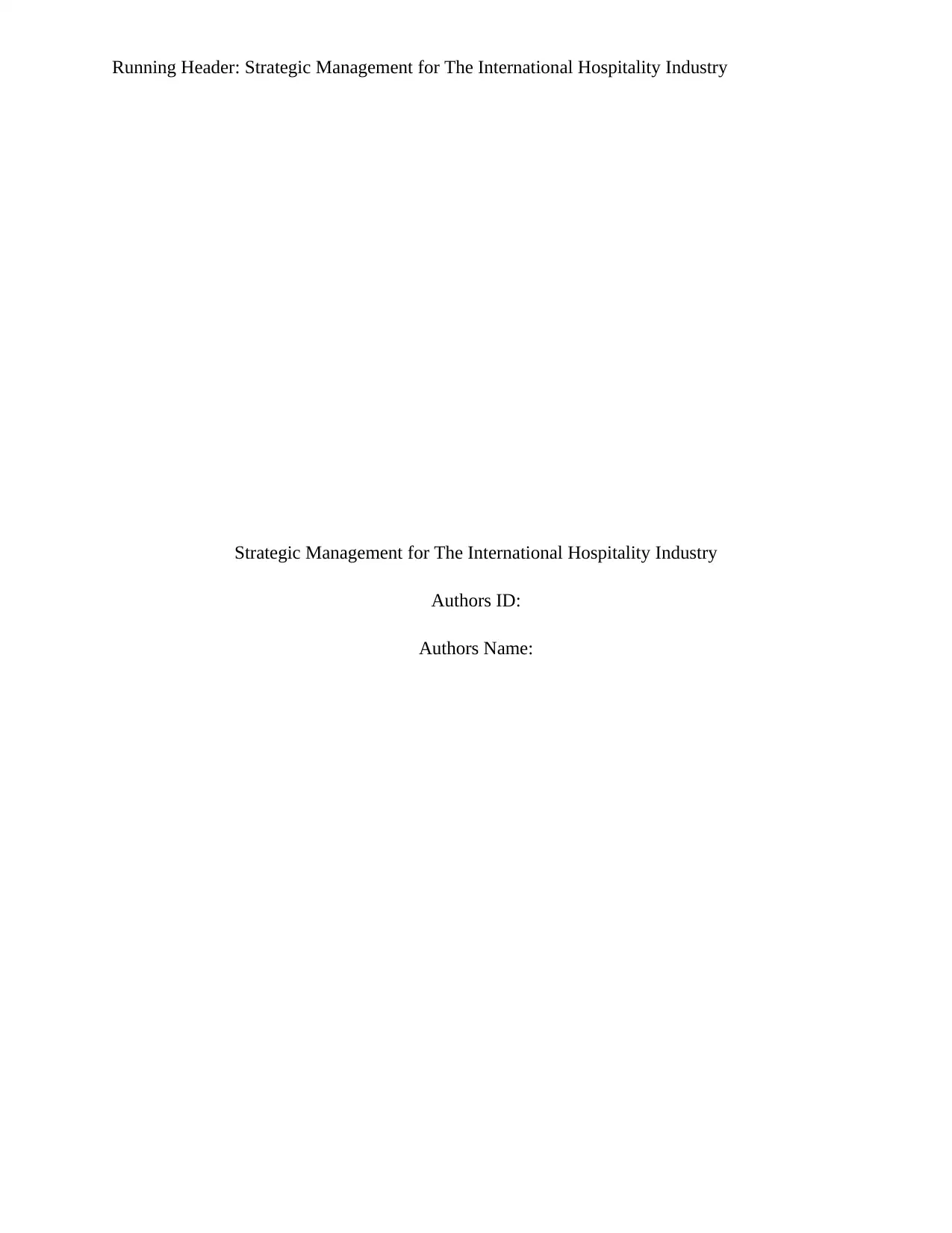
Running Header: Strategic Management for The International Hospitality Industry
Strategic Management for The International Hospitality Industry
Authors ID:
Authors Name:
Strategic Management for The International Hospitality Industry
Authors ID:
Authors Name:
Paraphrase This Document
Need a fresh take? Get an instant paraphrase of this document with our AI Paraphraser
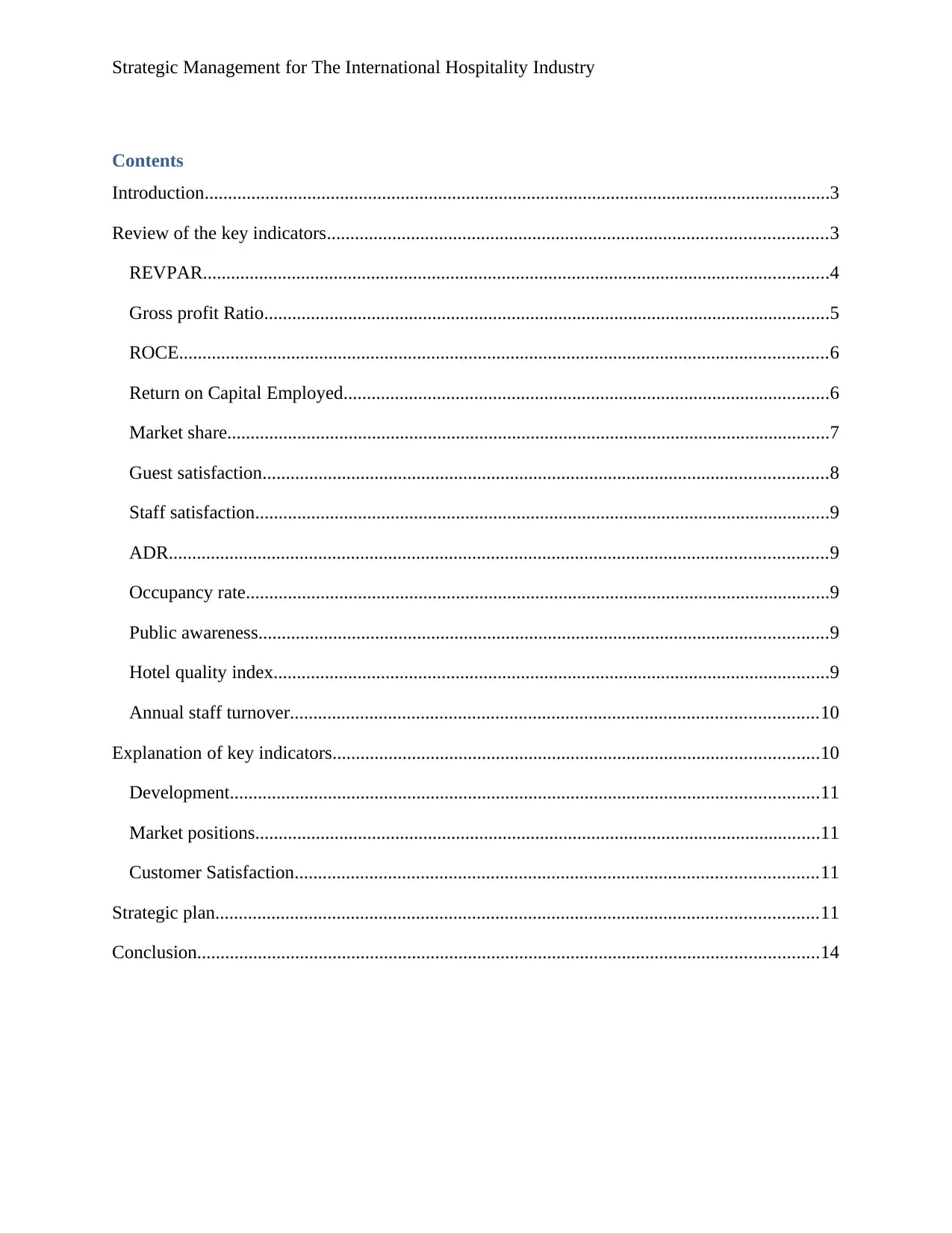
Strategic Management for The International Hospitality Industry
Contents
Introduction......................................................................................................................................3
Review of the key indicators...........................................................................................................3
REVPAR......................................................................................................................................4
Gross profit Ratio.........................................................................................................................5
ROCE...........................................................................................................................................6
Return on Capital Employed........................................................................................................6
Market share.................................................................................................................................7
Guest satisfaction.........................................................................................................................8
Staff satisfaction...........................................................................................................................9
ADR.............................................................................................................................................9
Occupancy rate.............................................................................................................................9
Public awareness..........................................................................................................................9
Hotel quality index.......................................................................................................................9
Annual staff turnover.................................................................................................................10
Explanation of key indicators........................................................................................................10
Development..............................................................................................................................11
Market positions.........................................................................................................................11
Customer Satisfaction................................................................................................................11
Strategic plan.................................................................................................................................11
Conclusion.....................................................................................................................................14
Contents
Introduction......................................................................................................................................3
Review of the key indicators...........................................................................................................3
REVPAR......................................................................................................................................4
Gross profit Ratio.........................................................................................................................5
ROCE...........................................................................................................................................6
Return on Capital Employed........................................................................................................6
Market share.................................................................................................................................7
Guest satisfaction.........................................................................................................................8
Staff satisfaction...........................................................................................................................9
ADR.............................................................................................................................................9
Occupancy rate.............................................................................................................................9
Public awareness..........................................................................................................................9
Hotel quality index.......................................................................................................................9
Annual staff turnover.................................................................................................................10
Explanation of key indicators........................................................................................................10
Development..............................................................................................................................11
Market positions.........................................................................................................................11
Customer Satisfaction................................................................................................................11
Strategic plan.................................................................................................................................11
Conclusion.....................................................................................................................................14
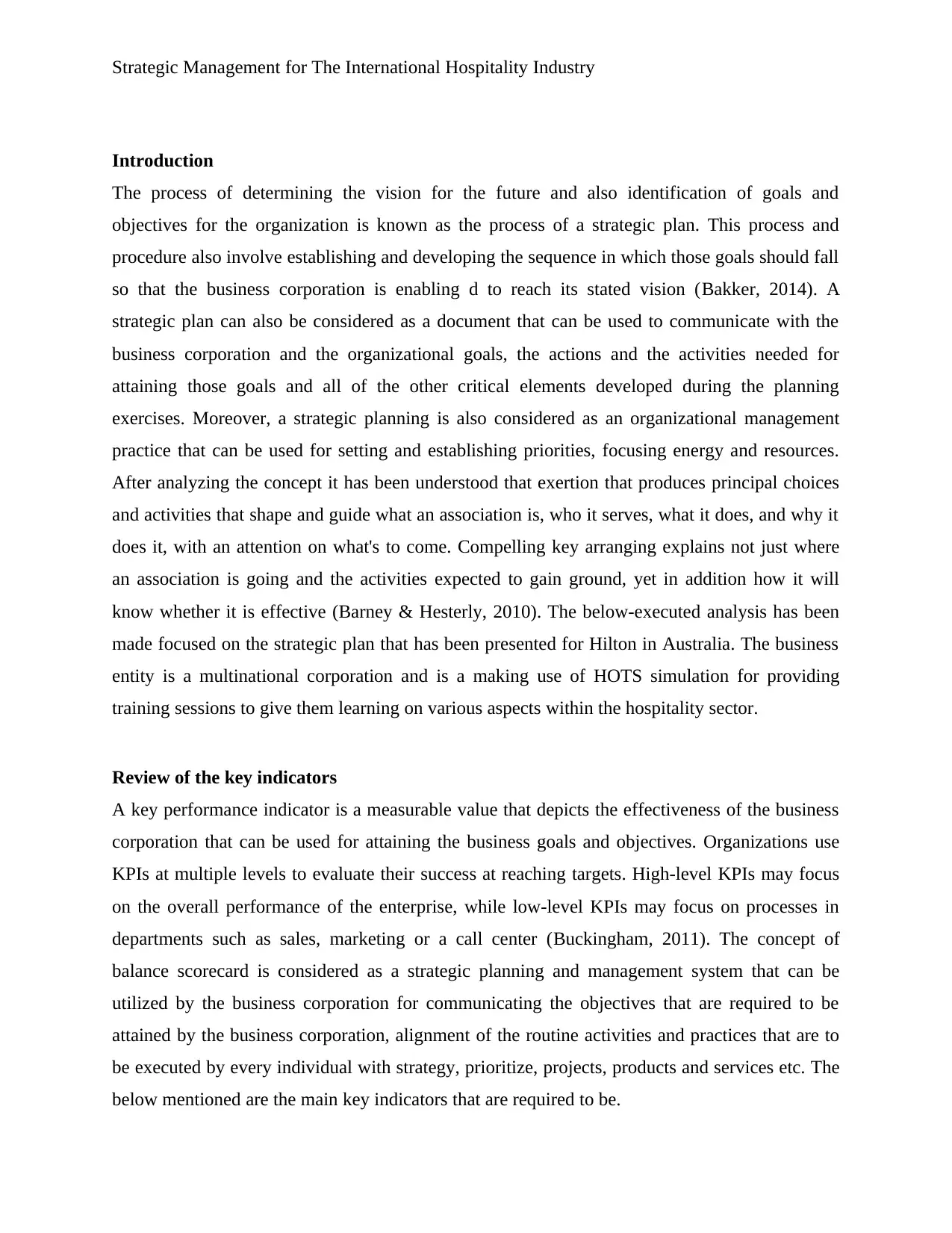
Strategic Management for The International Hospitality Industry
Introduction
The process of determining the vision for the future and also identification of goals and
objectives for the organization is known as the process of a strategic plan. This process and
procedure also involve establishing and developing the sequence in which those goals should fall
so that the business corporation is enabling d to reach its stated vision (Bakker, 2014). A
strategic plan can also be considered as a document that can be used to communicate with the
business corporation and the organizational goals, the actions and the activities needed for
attaining those goals and all of the other critical elements developed during the planning
exercises. Moreover, a strategic planning is also considered as an organizational management
practice that can be used for setting and establishing priorities, focusing energy and resources.
After analyzing the concept it has been understood that exertion that produces principal choices
and activities that shape and guide what an association is, who it serves, what it does, and why it
does it, with an attention on what's to come. Compelling key arranging explains not just where
an association is going and the activities expected to gain ground, yet in addition how it will
know whether it is effective (Barney & Hesterly, 2010). The below-executed analysis has been
made focused on the strategic plan that has been presented for Hilton in Australia. The business
entity is a multinational corporation and is a making use of HOTS simulation for providing
training sessions to give them learning on various aspects within the hospitality sector.
Review of the key indicators
A key performance indicator is a measurable value that depicts the effectiveness of the business
corporation that can be used for attaining the business goals and objectives. Organizations use
KPIs at multiple levels to evaluate their success at reaching targets. High-level KPIs may focus
on the overall performance of the enterprise, while low-level KPIs may focus on processes in
departments such as sales, marketing or a call center (Buckingham, 2011). The concept of
balance scorecard is considered as a strategic planning and management system that can be
utilized by the business corporation for communicating the objectives that are required to be
attained by the business corporation, alignment of the routine activities and practices that are to
be executed by every individual with strategy, prioritize, projects, products and services etc. The
below mentioned are the main key indicators that are required to be.
Introduction
The process of determining the vision for the future and also identification of goals and
objectives for the organization is known as the process of a strategic plan. This process and
procedure also involve establishing and developing the sequence in which those goals should fall
so that the business corporation is enabling d to reach its stated vision (Bakker, 2014). A
strategic plan can also be considered as a document that can be used to communicate with the
business corporation and the organizational goals, the actions and the activities needed for
attaining those goals and all of the other critical elements developed during the planning
exercises. Moreover, a strategic planning is also considered as an organizational management
practice that can be used for setting and establishing priorities, focusing energy and resources.
After analyzing the concept it has been understood that exertion that produces principal choices
and activities that shape and guide what an association is, who it serves, what it does, and why it
does it, with an attention on what's to come. Compelling key arranging explains not just where
an association is going and the activities expected to gain ground, yet in addition how it will
know whether it is effective (Barney & Hesterly, 2010). The below-executed analysis has been
made focused on the strategic plan that has been presented for Hilton in Australia. The business
entity is a multinational corporation and is a making use of HOTS simulation for providing
training sessions to give them learning on various aspects within the hospitality sector.
Review of the key indicators
A key performance indicator is a measurable value that depicts the effectiveness of the business
corporation that can be used for attaining the business goals and objectives. Organizations use
KPIs at multiple levels to evaluate their success at reaching targets. High-level KPIs may focus
on the overall performance of the enterprise, while low-level KPIs may focus on processes in
departments such as sales, marketing or a call center (Buckingham, 2011). The concept of
balance scorecard is considered as a strategic planning and management system that can be
utilized by the business corporation for communicating the objectives that are required to be
attained by the business corporation, alignment of the routine activities and practices that are to
be executed by every individual with strategy, prioritize, projects, products and services etc. The
below mentioned are the main key indicators that are required to be.
⊘ This is a preview!⊘
Do you want full access?
Subscribe today to unlock all pages.

Trusted by 1+ million students worldwide
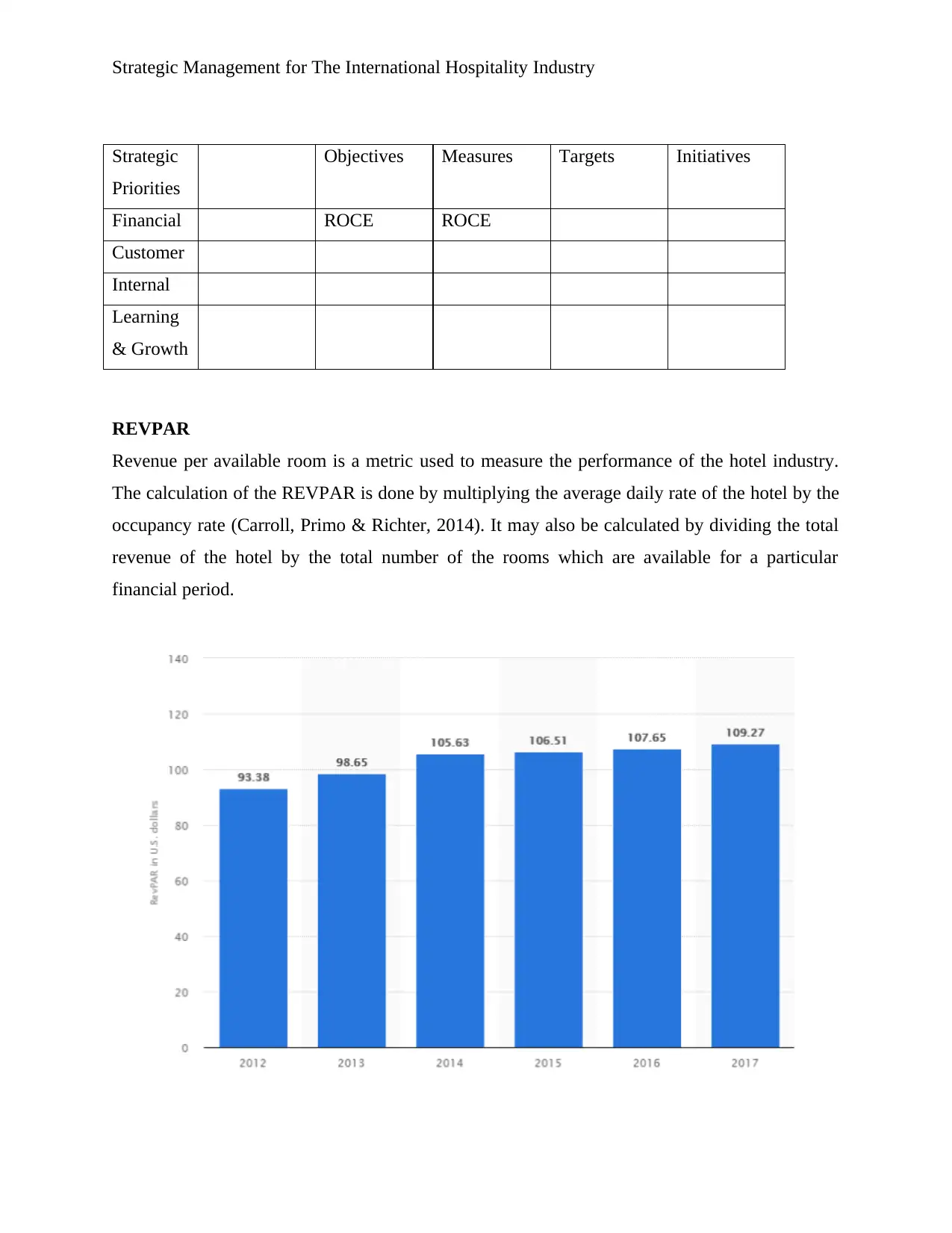
Strategic Management for The International Hospitality Industry
Strategic
Priorities
Objectives Measures Targets Initiatives
Financial ROCE ROCE
Customer
Internal
Learning
& Growth
REVPAR
Revenue per available room is a metric used to measure the performance of the hotel industry.
The calculation of the REVPAR is done by multiplying the average daily rate of the hotel by the
occupancy rate (Carroll, Primo & Richter, 2014). It may also be calculated by dividing the total
revenue of the hotel by the total number of the rooms which are available for a particular
financial period.
Strategic
Priorities
Objectives Measures Targets Initiatives
Financial ROCE ROCE
Customer
Internal
Learning
& Growth
REVPAR
Revenue per available room is a metric used to measure the performance of the hotel industry.
The calculation of the REVPAR is done by multiplying the average daily rate of the hotel by the
occupancy rate (Carroll, Primo & Richter, 2014). It may also be calculated by dividing the total
revenue of the hotel by the total number of the rooms which are available for a particular
financial period.
Paraphrase This Document
Need a fresh take? Get an instant paraphrase of this document with our AI Paraphraser
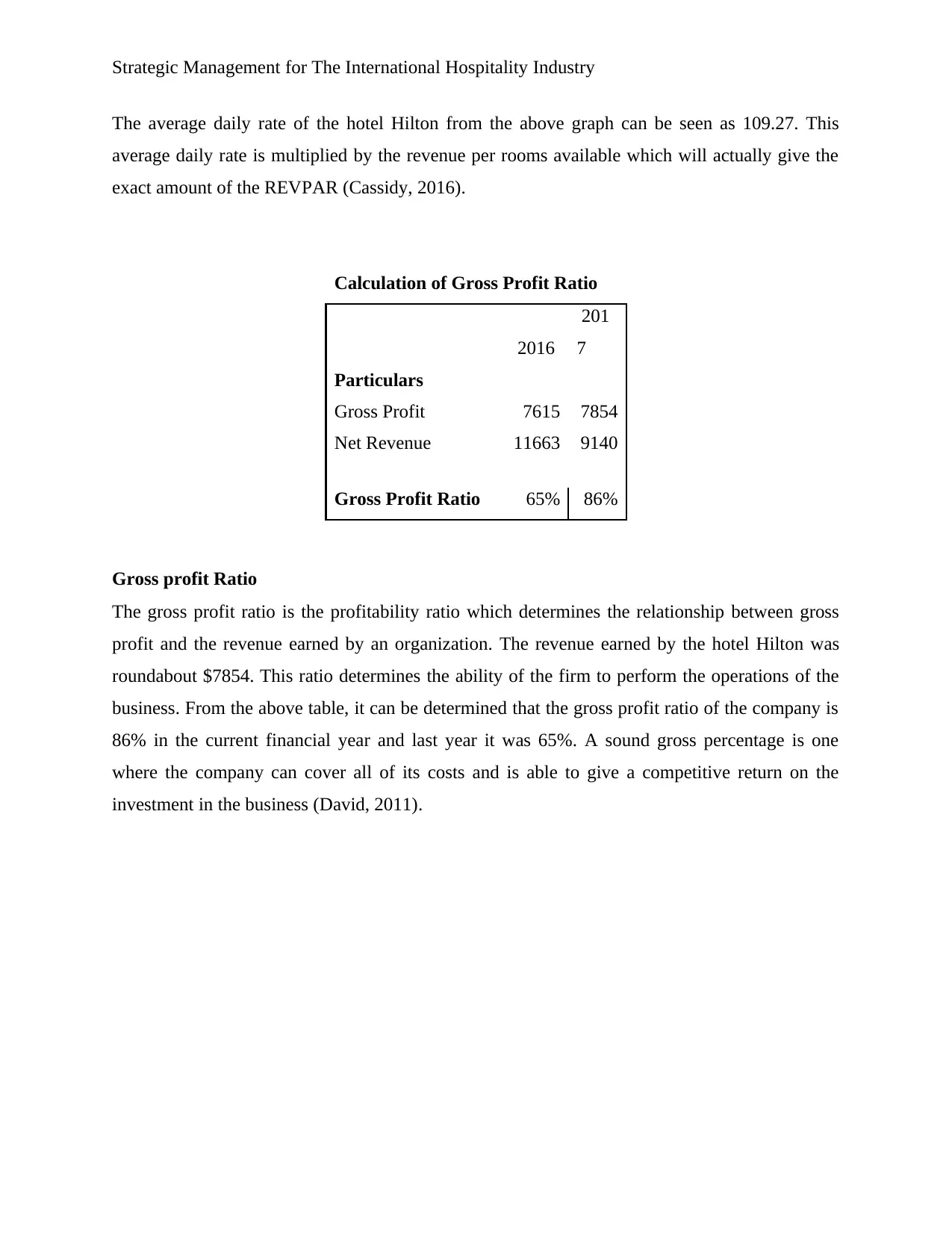
Strategic Management for The International Hospitality Industry
The average daily rate of the hotel Hilton from the above graph can be seen as 109.27. This
average daily rate is multiplied by the revenue per rooms available which will actually give the
exact amount of the REVPAR (Cassidy, 2016).
Calculation of Gross Profit Ratio
2016
201
7
Particulars
Gross Profit 7615 7854
Net Revenue 11663 9140
Gross Profit Ratio 65% 86%
Gross profit Ratio
The gross profit ratio is the profitability ratio which determines the relationship between gross
profit and the revenue earned by an organization. The revenue earned by the hotel Hilton was
roundabout $7854. This ratio determines the ability of the firm to perform the operations of the
business. From the above table, it can be determined that the gross profit ratio of the company is
86% in the current financial year and last year it was 65%. A sound gross percentage is one
where the company can cover all of its costs and is able to give a competitive return on the
investment in the business (David, 2011).
The average daily rate of the hotel Hilton from the above graph can be seen as 109.27. This
average daily rate is multiplied by the revenue per rooms available which will actually give the
exact amount of the REVPAR (Cassidy, 2016).
Calculation of Gross Profit Ratio
2016
201
7
Particulars
Gross Profit 7615 7854
Net Revenue 11663 9140
Gross Profit Ratio 65% 86%
Gross profit Ratio
The gross profit ratio is the profitability ratio which determines the relationship between gross
profit and the revenue earned by an organization. The revenue earned by the hotel Hilton was
roundabout $7854. This ratio determines the ability of the firm to perform the operations of the
business. From the above table, it can be determined that the gross profit ratio of the company is
86% in the current financial year and last year it was 65%. A sound gross percentage is one
where the company can cover all of its costs and is able to give a competitive return on the
investment in the business (David, 2011).
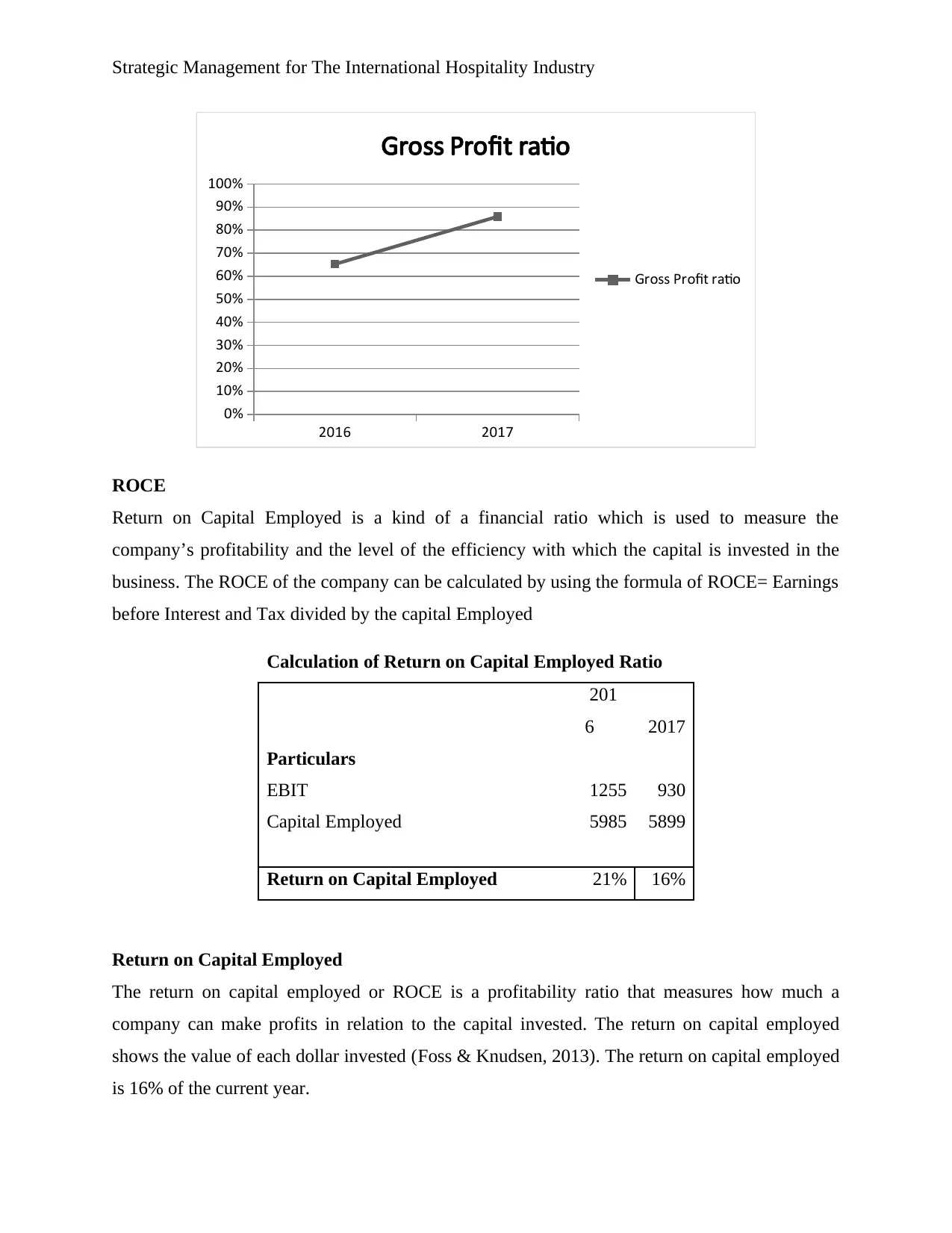
Strategic Management for The International Hospitality Industry
2016 2017
0%
10%
20%
30%
40%
50%
60%
70%
80%
90%
100%
Gross Profit ratio
Gross Profit ratio
ROCE
Return on Capital Employed is a kind of a financial ratio which is used to measure the
company’s profitability and the level of the efficiency with which the capital is invested in the
business. The ROCE of the company can be calculated by using the formula of ROCE= Earnings
before Interest and Tax divided by the capital Employed
Calculation of Return on Capital Employed Ratio
201
6 2017
Particulars
EBIT 1255 930
Capital Employed 5985 5899
Return on Capital Employed 21% 16%
Return on Capital Employed
The return on capital employed or ROCE is a profitability ratio that measures how much a
company can make profits in relation to the capital invested. The return on capital employed
shows the value of each dollar invested (Foss & Knudsen, 2013). The return on capital employed
is 16% of the current year.
2016 2017
0%
10%
20%
30%
40%
50%
60%
70%
80%
90%
100%
Gross Profit ratio
Gross Profit ratio
ROCE
Return on Capital Employed is a kind of a financial ratio which is used to measure the
company’s profitability and the level of the efficiency with which the capital is invested in the
business. The ROCE of the company can be calculated by using the formula of ROCE= Earnings
before Interest and Tax divided by the capital Employed
Calculation of Return on Capital Employed Ratio
201
6 2017
Particulars
EBIT 1255 930
Capital Employed 5985 5899
Return on Capital Employed 21% 16%
Return on Capital Employed
The return on capital employed or ROCE is a profitability ratio that measures how much a
company can make profits in relation to the capital invested. The return on capital employed
shows the value of each dollar invested (Foss & Knudsen, 2013). The return on capital employed
is 16% of the current year.
⊘ This is a preview!⊘
Do you want full access?
Subscribe today to unlock all pages.

Trusted by 1+ million students worldwide
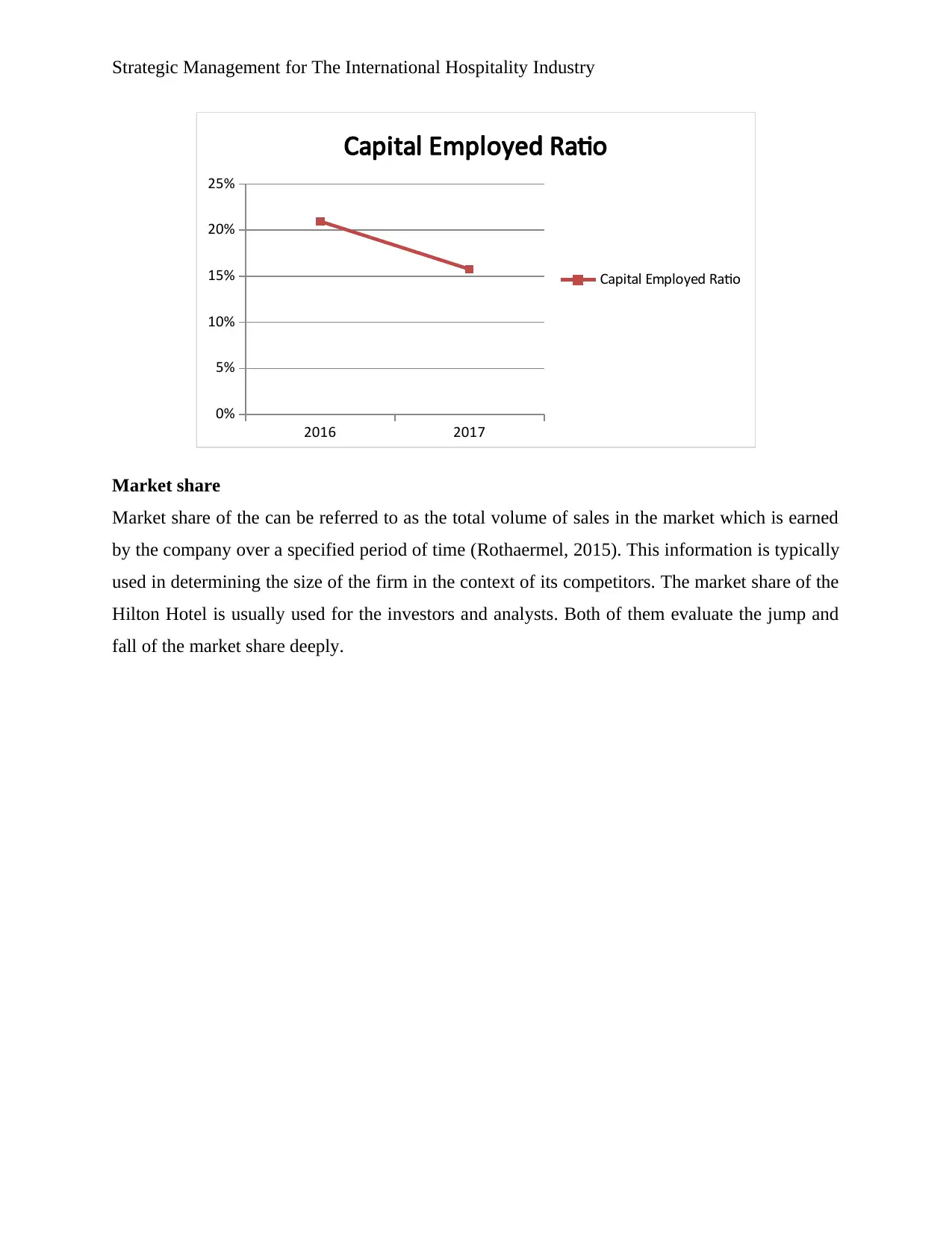
Strategic Management for The International Hospitality Industry
2016 2017
0%
5%
10%
15%
20%
25%
Capital Employed Ratio
Capital Employed Ratio
Market share
Market share of the can be referred to as the total volume of sales in the market which is earned
by the company over a specified period of time (Rothaermel, 2015). This information is typically
used in determining the size of the firm in the context of its competitors. The market share of the
Hilton Hotel is usually used for the investors and analysts. Both of them evaluate the jump and
fall of the market share deeply.
2016 2017
0%
5%
10%
15%
20%
25%
Capital Employed Ratio
Capital Employed Ratio
Market share
Market share of the can be referred to as the total volume of sales in the market which is earned
by the company over a specified period of time (Rothaermel, 2015). This information is typically
used in determining the size of the firm in the context of its competitors. The market share of the
Hilton Hotel is usually used for the investors and analysts. Both of them evaluate the jump and
fall of the market share deeply.
Paraphrase This Document
Need a fresh take? Get an instant paraphrase of this document with our AI Paraphraser
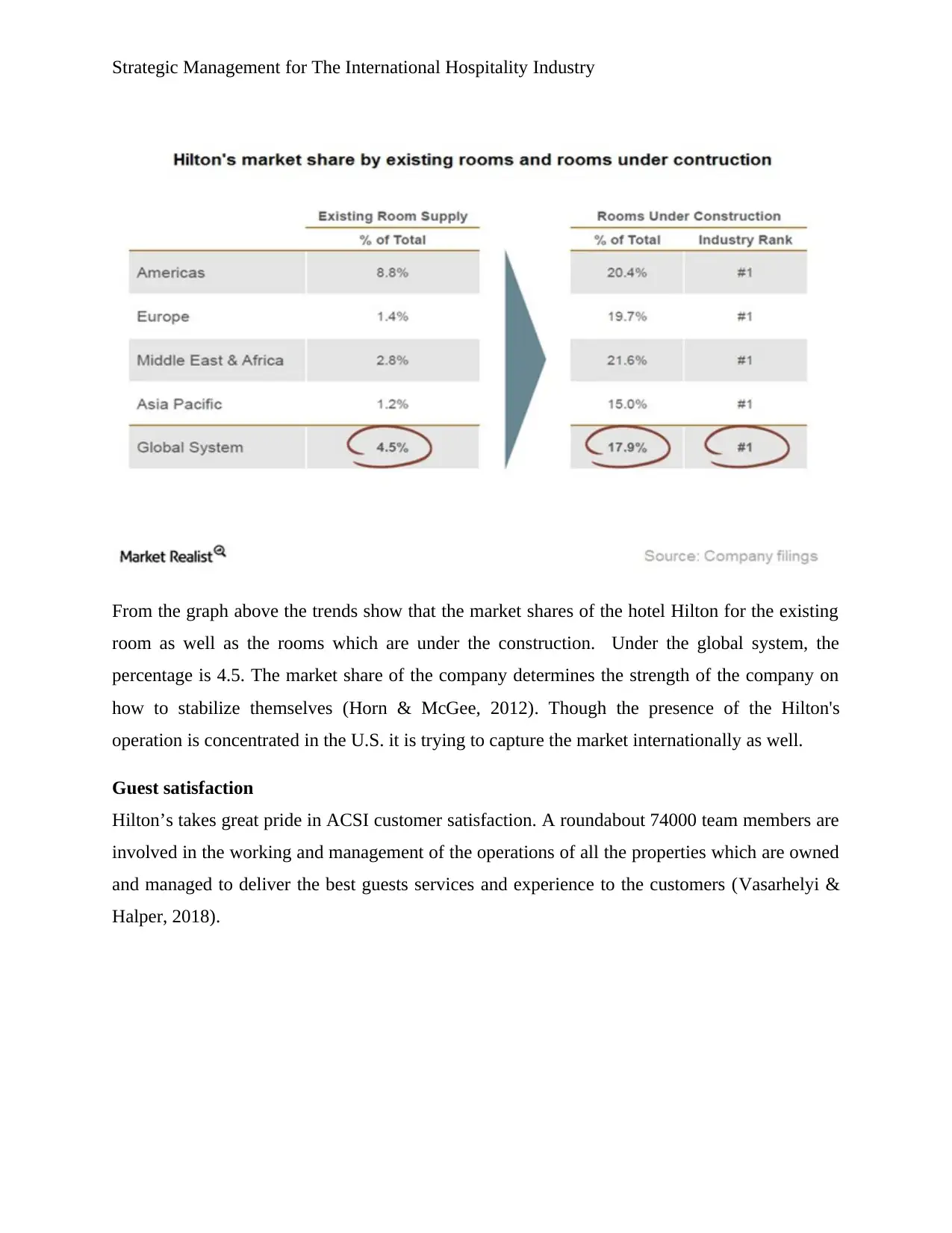
Strategic Management for The International Hospitality Industry
From the graph above the trends show that the market shares of the hotel Hilton for the existing
room as well as the rooms which are under the construction. Under the global system, the
percentage is 4.5. The market share of the company determines the strength of the company on
how to stabilize themselves (Horn & McGee, 2012). Though the presence of the Hilton's
operation is concentrated in the U.S. it is trying to capture the market internationally as well.
Guest satisfaction
Hilton’s takes great pride in ACSI customer satisfaction. A roundabout 74000 team members are
involved in the working and management of the operations of all the properties which are owned
and managed to deliver the best guests services and experience to the customers (Vasarhelyi &
Halper, 2018).
From the graph above the trends show that the market shares of the hotel Hilton for the existing
room as well as the rooms which are under the construction. Under the global system, the
percentage is 4.5. The market share of the company determines the strength of the company on
how to stabilize themselves (Horn & McGee, 2012). Though the presence of the Hilton's
operation is concentrated in the U.S. it is trying to capture the market internationally as well.
Guest satisfaction
Hilton’s takes great pride in ACSI customer satisfaction. A roundabout 74000 team members are
involved in the working and management of the operations of all the properties which are owned
and managed to deliver the best guests services and experience to the customers (Vasarhelyi &
Halper, 2018).
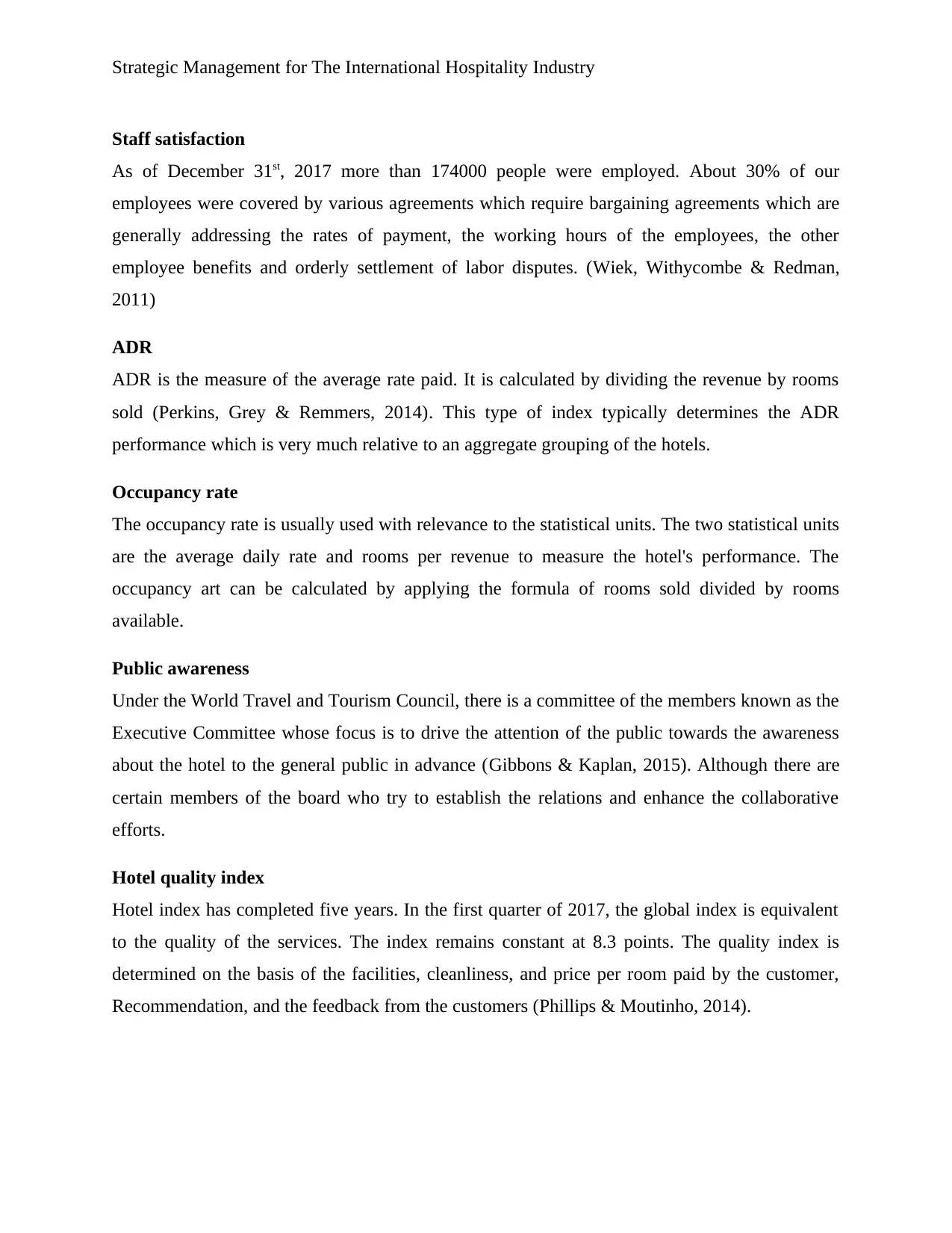
Strategic Management for The International Hospitality Industry
Staff satisfaction
As of December 31st, 2017 more than 174000 people were employed. About 30% of our
employees were covered by various agreements which require bargaining agreements which are
generally addressing the rates of payment, the working hours of the employees, the other
employee benefits and orderly settlement of labor disputes. (Wiek, Withycombe & Redman,
2011)
ADR
ADR is the measure of the average rate paid. It is calculated by dividing the revenue by rooms
sold (Perkins, Grey & Remmers, 2014). This type of index typically determines the ADR
performance which is very much relative to an aggregate grouping of the hotels.
Occupancy rate
The occupancy rate is usually used with relevance to the statistical units. The two statistical units
are the average daily rate and rooms per revenue to measure the hotel's performance. The
occupancy art can be calculated by applying the formula of rooms sold divided by rooms
available.
Public awareness
Under the World Travel and Tourism Council, there is a committee of the members known as the
Executive Committee whose focus is to drive the attention of the public towards the awareness
about the hotel to the general public in advance (Gibbons & Kaplan, 2015). Although there are
certain members of the board who try to establish the relations and enhance the collaborative
efforts.
Hotel quality index
Hotel index has completed five years. In the first quarter of 2017, the global index is equivalent
to the quality of the services. The index remains constant at 8.3 points. The quality index is
determined on the basis of the facilities, cleanliness, and price per room paid by the customer,
Recommendation, and the feedback from the customers (Phillips & Moutinho, 2014).
Staff satisfaction
As of December 31st, 2017 more than 174000 people were employed. About 30% of our
employees were covered by various agreements which require bargaining agreements which are
generally addressing the rates of payment, the working hours of the employees, the other
employee benefits and orderly settlement of labor disputes. (Wiek, Withycombe & Redman,
2011)
ADR
ADR is the measure of the average rate paid. It is calculated by dividing the revenue by rooms
sold (Perkins, Grey & Remmers, 2014). This type of index typically determines the ADR
performance which is very much relative to an aggregate grouping of the hotels.
Occupancy rate
The occupancy rate is usually used with relevance to the statistical units. The two statistical units
are the average daily rate and rooms per revenue to measure the hotel's performance. The
occupancy art can be calculated by applying the formula of rooms sold divided by rooms
available.
Public awareness
Under the World Travel and Tourism Council, there is a committee of the members known as the
Executive Committee whose focus is to drive the attention of the public towards the awareness
about the hotel to the general public in advance (Gibbons & Kaplan, 2015). Although there are
certain members of the board who try to establish the relations and enhance the collaborative
efforts.
Hotel quality index
Hotel index has completed five years. In the first quarter of 2017, the global index is equivalent
to the quality of the services. The index remains constant at 8.3 points. The quality index is
determined on the basis of the facilities, cleanliness, and price per room paid by the customer,
Recommendation, and the feedback from the customers (Phillips & Moutinho, 2014).
⊘ This is a preview!⊘
Do you want full access?
Subscribe today to unlock all pages.

Trusted by 1+ million students worldwide
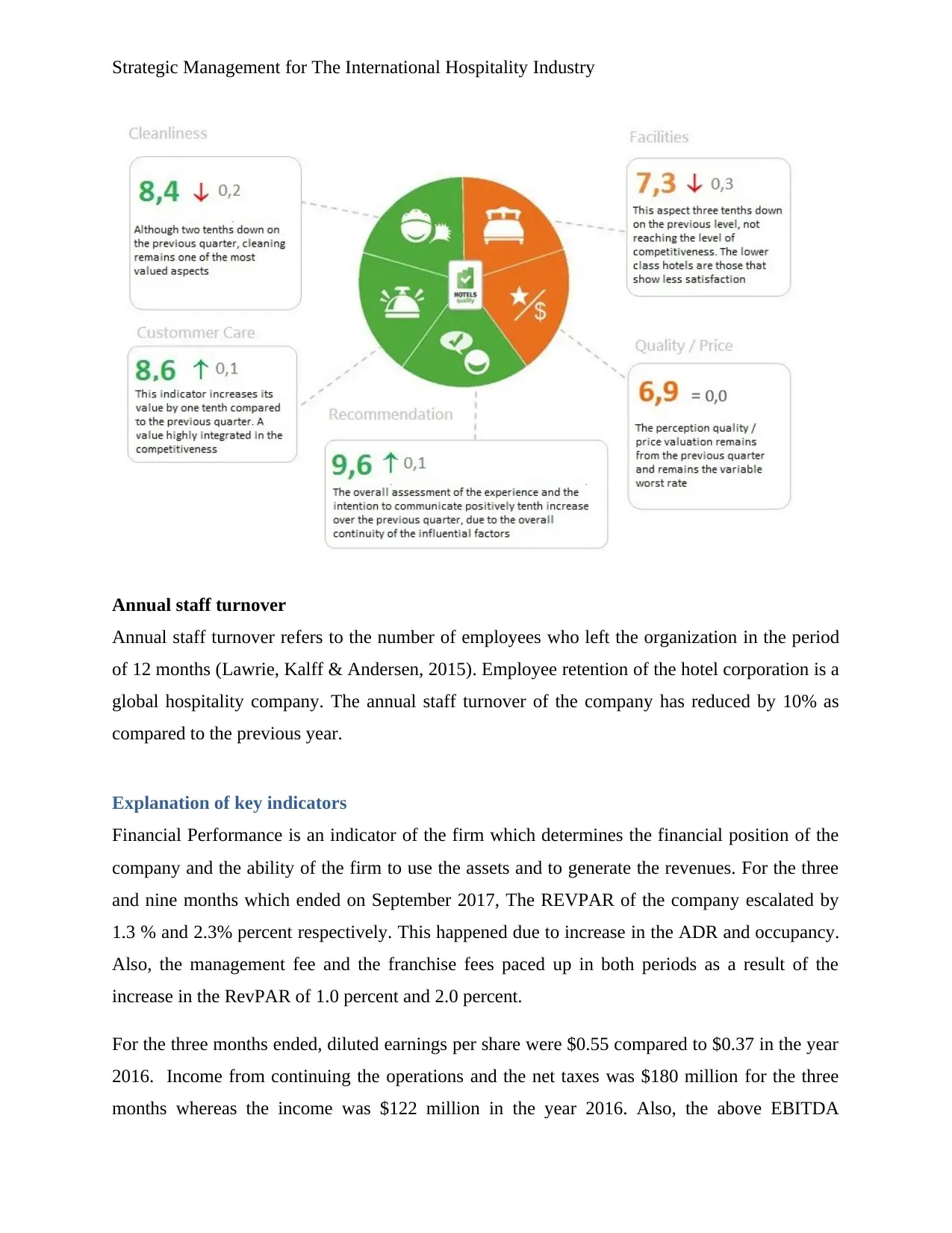
Strategic Management for The International Hospitality Industry
Annual staff turnover
Annual staff turnover refers to the number of employees who left the organization in the period
of 12 months (Lawrie, Kalff & Andersen, 2015). Employee retention of the hotel corporation is a
global hospitality company. The annual staff turnover of the company has reduced by 10% as
compared to the previous year.
Explanation of key indicators
Financial Performance is an indicator of the firm which determines the financial position of the
company and the ability of the firm to use the assets and to generate the revenues. For the three
and nine months which ended on September 2017, The REVPAR of the company escalated by
1.3 % and 2.3% percent respectively. This happened due to increase in the ADR and occupancy.
Also, the management fee and the franchise fees paced up in both periods as a result of the
increase in the RevPAR of 1.0 percent and 2.0 percent.
For the three months ended, diluted earnings per share were $0.55 compared to $0.37 in the year
2016. Income from continuing the operations and the net taxes was $180 million for the three
months whereas the income was $122 million in the year 2016. Also, the above EBITDA
Annual staff turnover
Annual staff turnover refers to the number of employees who left the organization in the period
of 12 months (Lawrie, Kalff & Andersen, 2015). Employee retention of the hotel corporation is a
global hospitality company. The annual staff turnover of the company has reduced by 10% as
compared to the previous year.
Explanation of key indicators
Financial Performance is an indicator of the firm which determines the financial position of the
company and the ability of the firm to use the assets and to generate the revenues. For the three
and nine months which ended on September 2017, The REVPAR of the company escalated by
1.3 % and 2.3% percent respectively. This happened due to increase in the ADR and occupancy.
Also, the management fee and the franchise fees paced up in both periods as a result of the
increase in the RevPAR of 1.0 percent and 2.0 percent.
For the three months ended, diluted earnings per share were $0.55 compared to $0.37 in the year
2016. Income from continuing the operations and the net taxes was $180 million for the three
months whereas the income was $122 million in the year 2016. Also, the above EBITDA
Paraphrase This Document
Need a fresh take? Get an instant paraphrase of this document with our AI Paraphraser
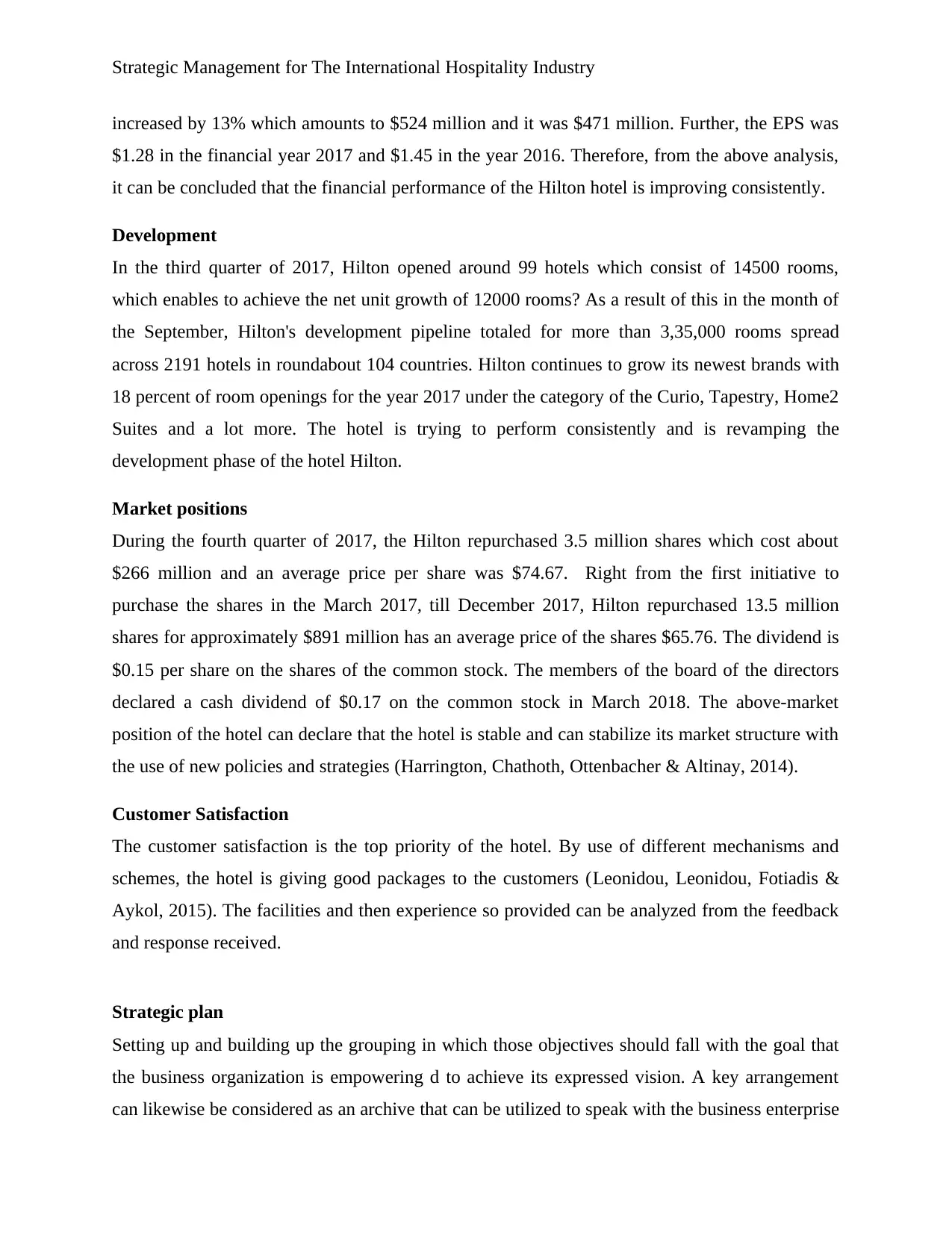
Strategic Management for The International Hospitality Industry
increased by 13% which amounts to $524 million and it was $471 million. Further, the EPS was
$1.28 in the financial year 2017 and $1.45 in the year 2016. Therefore, from the above analysis,
it can be concluded that the financial performance of the Hilton hotel is improving consistently.
Development
In the third quarter of 2017, Hilton opened around 99 hotels which consist of 14500 rooms,
which enables to achieve the net unit growth of 12000 rooms? As a result of this in the month of
the September, Hilton's development pipeline totaled for more than 3,35,000 rooms spread
across 2191 hotels in roundabout 104 countries. Hilton continues to grow its newest brands with
18 percent of room openings for the year 2017 under the category of the Curio, Tapestry, Home2
Suites and a lot more. The hotel is trying to perform consistently and is revamping the
development phase of the hotel Hilton.
Market positions
During the fourth quarter of 2017, the Hilton repurchased 3.5 million shares which cost about
$266 million and an average price per share was $74.67. Right from the first initiative to
purchase the shares in the March 2017, till December 2017, Hilton repurchased 13.5 million
shares for approximately $891 million has an average price of the shares $65.76. The dividend is
$0.15 per share on the shares of the common stock. The members of the board of the directors
declared a cash dividend of $0.17 on the common stock in March 2018. The above-market
position of the hotel can declare that the hotel is stable and can stabilize its market structure with
the use of new policies and strategies (Harrington, Chathoth, Ottenbacher & Altinay, 2014).
Customer Satisfaction
The customer satisfaction is the top priority of the hotel. By use of different mechanisms and
schemes, the hotel is giving good packages to the customers (Leonidou, Leonidou, Fotiadis &
Aykol, 2015). The facilities and then experience so provided can be analyzed from the feedback
and response received.
Strategic plan
Setting up and building up the grouping in which those objectives should fall with the goal that
the business organization is empowering d to achieve its expressed vision. A key arrangement
can likewise be considered as an archive that can be utilized to speak with the business enterprise
increased by 13% which amounts to $524 million and it was $471 million. Further, the EPS was
$1.28 in the financial year 2017 and $1.45 in the year 2016. Therefore, from the above analysis,
it can be concluded that the financial performance of the Hilton hotel is improving consistently.
Development
In the third quarter of 2017, Hilton opened around 99 hotels which consist of 14500 rooms,
which enables to achieve the net unit growth of 12000 rooms? As a result of this in the month of
the September, Hilton's development pipeline totaled for more than 3,35,000 rooms spread
across 2191 hotels in roundabout 104 countries. Hilton continues to grow its newest brands with
18 percent of room openings for the year 2017 under the category of the Curio, Tapestry, Home2
Suites and a lot more. The hotel is trying to perform consistently and is revamping the
development phase of the hotel Hilton.
Market positions
During the fourth quarter of 2017, the Hilton repurchased 3.5 million shares which cost about
$266 million and an average price per share was $74.67. Right from the first initiative to
purchase the shares in the March 2017, till December 2017, Hilton repurchased 13.5 million
shares for approximately $891 million has an average price of the shares $65.76. The dividend is
$0.15 per share on the shares of the common stock. The members of the board of the directors
declared a cash dividend of $0.17 on the common stock in March 2018. The above-market
position of the hotel can declare that the hotel is stable and can stabilize its market structure with
the use of new policies and strategies (Harrington, Chathoth, Ottenbacher & Altinay, 2014).
Customer Satisfaction
The customer satisfaction is the top priority of the hotel. By use of different mechanisms and
schemes, the hotel is giving good packages to the customers (Leonidou, Leonidou, Fotiadis &
Aykol, 2015). The facilities and then experience so provided can be analyzed from the feedback
and response received.
Strategic plan
Setting up and building up the grouping in which those objectives should fall with the goal that
the business organization is empowering d to achieve its expressed vision. A key arrangement
can likewise be considered as an archive that can be utilized to speak with the business enterprise
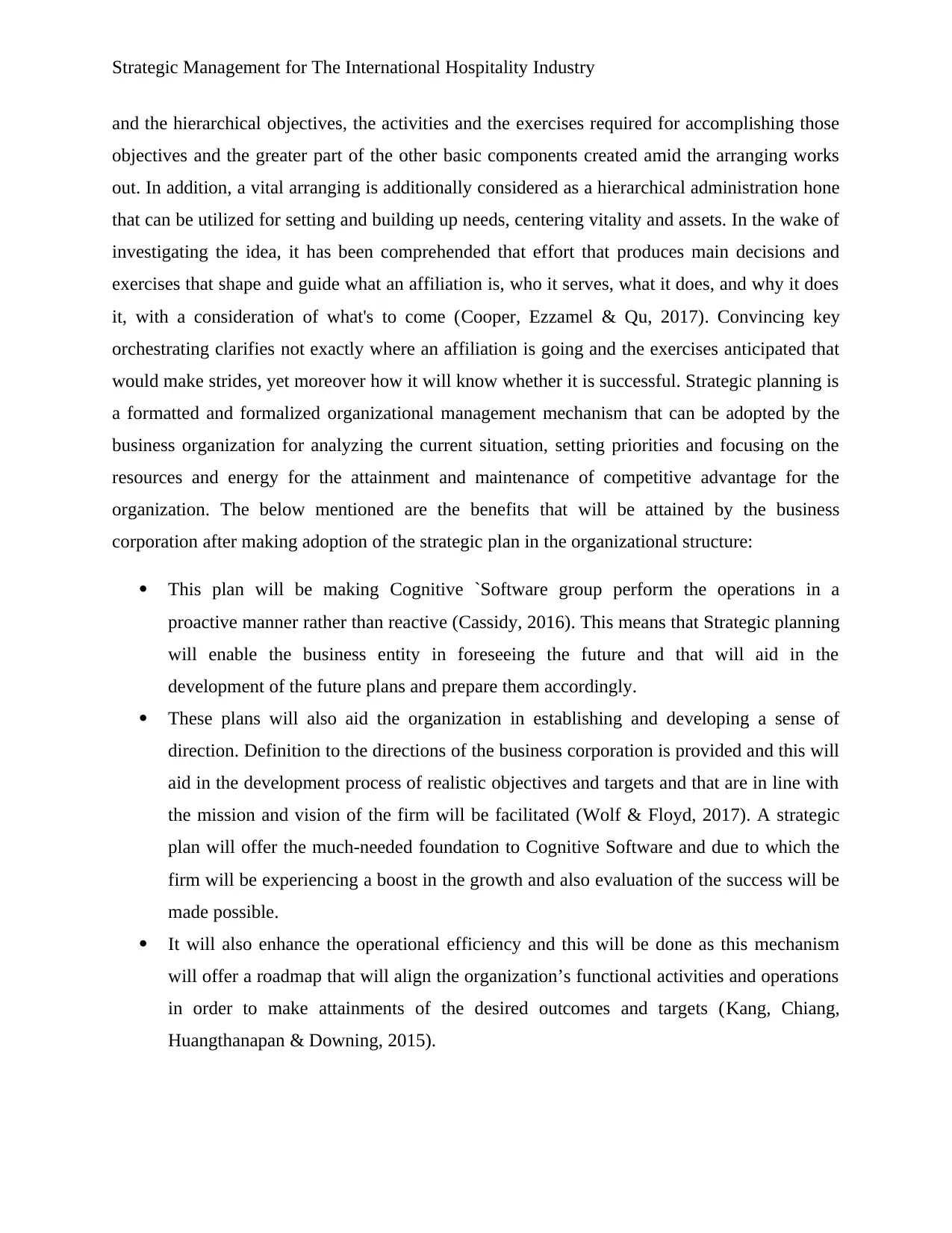
Strategic Management for The International Hospitality Industry
and the hierarchical objectives, the activities and the exercises required for accomplishing those
objectives and the greater part of the other basic components created amid the arranging works
out. In addition, a vital arranging is additionally considered as a hierarchical administration hone
that can be utilized for setting and building up needs, centering vitality and assets. In the wake of
investigating the idea, it has been comprehended that effort that produces main decisions and
exercises that shape and guide what an affiliation is, who it serves, what it does, and why it does
it, with a consideration of what's to come (Cooper, Ezzamel & Qu, 2017). Convincing key
orchestrating clarifies not exactly where an affiliation is going and the exercises anticipated that
would make strides, yet moreover how it will know whether it is successful. Strategic planning is
a formatted and formalized organizational management mechanism that can be adopted by the
business organization for analyzing the current situation, setting priorities and focusing on the
resources and energy for the attainment and maintenance of competitive advantage for the
organization. The below mentioned are the benefits that will be attained by the business
corporation after making adoption of the strategic plan in the organizational structure:
This plan will be making Cognitive `Software group perform the operations in a
proactive manner rather than reactive (Cassidy, 2016). This means that Strategic planning
will enable the business entity in foreseeing the future and that will aid in the
development of the future plans and prepare them accordingly.
These plans will also aid the organization in establishing and developing a sense of
direction. Definition to the directions of the business corporation is provided and this will
aid in the development process of realistic objectives and targets and that are in line with
the mission and vision of the firm will be facilitated (Wolf & Floyd, 2017). A strategic
plan will offer the much-needed foundation to Cognitive Software and due to which the
firm will be experiencing a boost in the growth and also evaluation of the success will be
made possible.
It will also enhance the operational efficiency and this will be done as this mechanism
will offer a roadmap that will align the organization’s functional activities and operations
in order to make attainments of the desired outcomes and targets (Kang, Chiang,
Huangthanapan & Downing, 2015).
and the hierarchical objectives, the activities and the exercises required for accomplishing those
objectives and the greater part of the other basic components created amid the arranging works
out. In addition, a vital arranging is additionally considered as a hierarchical administration hone
that can be utilized for setting and building up needs, centering vitality and assets. In the wake of
investigating the idea, it has been comprehended that effort that produces main decisions and
exercises that shape and guide what an affiliation is, who it serves, what it does, and why it does
it, with a consideration of what's to come (Cooper, Ezzamel & Qu, 2017). Convincing key
orchestrating clarifies not exactly where an affiliation is going and the exercises anticipated that
would make strides, yet moreover how it will know whether it is successful. Strategic planning is
a formatted and formalized organizational management mechanism that can be adopted by the
business organization for analyzing the current situation, setting priorities and focusing on the
resources and energy for the attainment and maintenance of competitive advantage for the
organization. The below mentioned are the benefits that will be attained by the business
corporation after making adoption of the strategic plan in the organizational structure:
This plan will be making Cognitive `Software group perform the operations in a
proactive manner rather than reactive (Cassidy, 2016). This means that Strategic planning
will enable the business entity in foreseeing the future and that will aid in the
development of the future plans and prepare them accordingly.
These plans will also aid the organization in establishing and developing a sense of
direction. Definition to the directions of the business corporation is provided and this will
aid in the development process of realistic objectives and targets and that are in line with
the mission and vision of the firm will be facilitated (Wolf & Floyd, 2017). A strategic
plan will offer the much-needed foundation to Cognitive Software and due to which the
firm will be experiencing a boost in the growth and also evaluation of the success will be
made possible.
It will also enhance the operational efficiency and this will be done as this mechanism
will offer a roadmap that will align the organization’s functional activities and operations
in order to make attainments of the desired outcomes and targets (Kang, Chiang,
Huangthanapan & Downing, 2015).
⊘ This is a preview!⊘
Do you want full access?
Subscribe today to unlock all pages.

Trusted by 1+ million students worldwide
1 out of 17
Related Documents
Your All-in-One AI-Powered Toolkit for Academic Success.
+13062052269
info@desklib.com
Available 24*7 on WhatsApp / Email
![[object Object]](/_next/static/media/star-bottom.7253800d.svg)
Unlock your academic potential
Copyright © 2020–2025 A2Z Services. All Rights Reserved. Developed and managed by ZUCOL.





